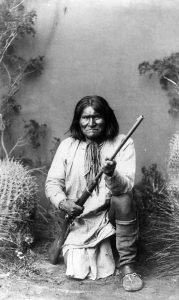
Geronimo, 1887
Geronimo (June 1829 – February 17, 1909) was a Native American resistance leader from the Bedonkohe band of the Chiricahua Apache tribe. He was best known for leading his warriors on violent raids against Mexican and U.S. targets and for escaping confinement on the Apache reservation multiple times.
Geronimo (Native American name Goyathlay) was born in what is now New Mexico. When Mexico ceded much of the American Southwest to the United States following the end of the Mexican-American War, Anglo-Americans began settling lands that had traditionally been used by the Apache. Tensions broke out between the Apache and settlers, resulting in violence and death on both sides.
There were also longstanding tensions between the Apache and Mexicans, and in 1858 Mexican soldiers killed Geronimo’s mother, wife, and three children. This led to Geronimo’s subsequent long campaign of revenge against Mexicans.
The Apache were moved to the San Carlos Reservation in Arizona in the mid-1870s, but Geronimo escaped from the reservation with a band of followers three separate times. The U.S. Army was sent after him, and he surrendered for the final time in 1886.
After being held in Texas, Florida, and Alabama, Geronimo was finally incarcerated in 1894 at Fort Sill, Oklahoma, where he remained for the rest of his life, though he was allowed some public appearances. He co-authored an autobiography called Geronimo: His Own Story in 1905. Geronimo died in 1909 after being thrown from a horse.
Learn more about Geronimo through historical newspapers from our archives. Explore newspaper articles, headlines, images, and other primary sources below.
Articles and Clippings about Geronimo
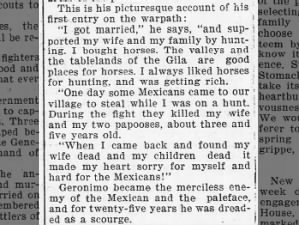 Story of the murder of Geronimo's family in 1858 Fri, Apr 4, 1902 – Page 6 · The Charlotte News (Charlotte, North Carolina) · Newspapers.com
Story of the murder of Geronimo's family in 1858 Fri, Apr 4, 1902 – Page 6 · The Charlotte News (Charlotte, North Carolina) · Newspapers.com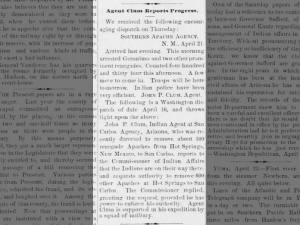 1877 capture of Geronimo and removal of "renegade" Apache to the San Carlos Reservation in Arizona Sat, Apr 28, 1877 – Page 2 · Arizona Weekly Citizen (Tucson, Arizona) · Newspapers.com
1877 capture of Geronimo and removal of "renegade" Apache to the San Carlos Reservation in Arizona Sat, Apr 28, 1877 – Page 2 · Arizona Weekly Citizen (Tucson, Arizona) · Newspapers.com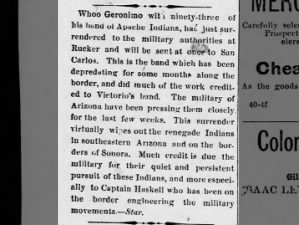 1880 account of capture of Geronimo by US Army Sat, Jan 10, 1880 – Page 4 · The Arizona Sentinel (Yuma, Arizona) · Newspapers.com
1880 account of capture of Geronimo by US Army Sat, Jan 10, 1880 – Page 4 · The Arizona Sentinel (Yuma, Arizona) · Newspapers.com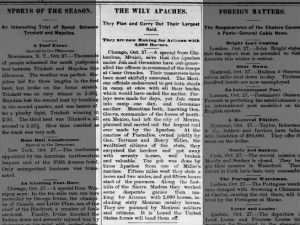 Geronimo and other Apache outmaneuver Mexican Army, 1883 Sun, Oct 28, 1883 – 4 · Quad-City Times (Davenport, Iowa) · Newspapers.com
Geronimo and other Apache outmaneuver Mexican Army, 1883 Sun, Oct 28, 1883 – 4 · Quad-City Times (Davenport, Iowa) · Newspapers.com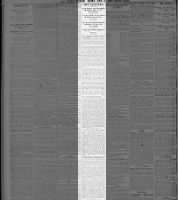 General Crook discusses Apache surrender in 1883; believes peace is possible 22 Jun 1883, Fri Chicago Tribune (Chicago, Illinois) Newspapers.com
General Crook discusses Apache surrender in 1883; believes peace is possible 22 Jun 1883, Fri Chicago Tribune (Chicago, Illinois) Newspapers.com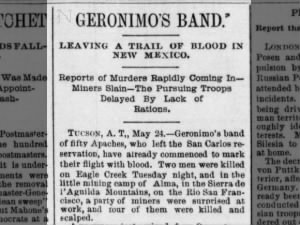 Geronimo and followers accused in 1885 of murdering 2 miners after escaping San Carlos Reservation Mon, May 25, 1885 – Page 1 · The Philadelphia Inquirer (Philadelphia, Pennsylvania) · Newspapers.com
Geronimo and followers accused in 1885 of murdering 2 miners after escaping San Carlos Reservation Mon, May 25, 1885 – Page 1 · The Philadelphia Inquirer (Philadelphia, Pennsylvania) · Newspapers.com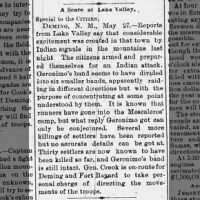 Newspaper reports on Geronimo's activities in New Mexico in May 1885 30 May 1885, Sat Arizona Weekly Citizen (Tucson, Arizona) Newspapers.com
Newspaper reports on Geronimo's activities in New Mexico in May 1885 30 May 1885, Sat Arizona Weekly Citizen (Tucson, Arizona) Newspapers.com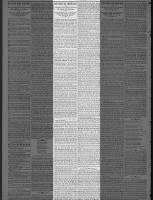 John P. Clum describes his role in the 1877 capture of Geronimo 19 Jul 1885, Sun The Indianapolis Journal (Indianapolis, Indiana) Newspapers.com
John P. Clum describes his role in the 1877 capture of Geronimo 19 Jul 1885, Sun The Indianapolis Journal (Indianapolis, Indiana) Newspapers.com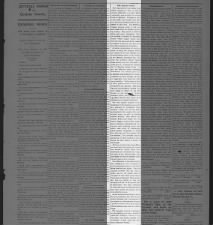 1886 summary of the difficulties the US Army faced in fighting the Apache Mon, Jan 25, 1886 – Page 3 · The Daily Tombstone (Tombstone, Arizona) · Newspapers.com
1886 summary of the difficulties the US Army faced in fighting the Apache Mon, Jan 25, 1886 – Page 3 · The Daily Tombstone (Tombstone, Arizona) · Newspapers.com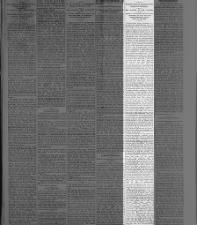 Firsthand account of Geronimo's final surrender in 1886 and the events leading up to it Thu, Sep 16, 1886 – Page 1 · The Leavenworth Weekly Times (Leavenworth, Kansas) · Newspapers.com
Firsthand account of Geronimo's final surrender in 1886 and the events leading up to it Thu, Sep 16, 1886 – Page 1 · The Leavenworth Weekly Times (Leavenworth, Kansas) · Newspapers.com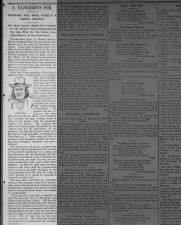 Reactions to news of Geronimo's final surrender in 1886 Sat, Sep 11, 1886 – 5 · Dollar Weekly News (Wilkes-Barre, Pennsylvania) · Newspapers.com
Reactions to news of Geronimo's final surrender in 1886 Sat, Sep 11, 1886 – 5 · Dollar Weekly News (Wilkes-Barre, Pennsylvania) · Newspapers.com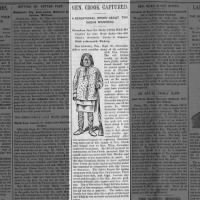 Geronimo reportedly claims to have captured and negotiated an agreement with General George Crook 24 Sep 1886, Fri The Sentinel (Carlisle, Pennsylvania) Newspapers.com
Geronimo reportedly claims to have captured and negotiated an agreement with General George Crook 24 Sep 1886, Fri The Sentinel (Carlisle, Pennsylvania) Newspapers.com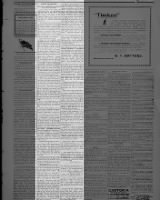 Former U.S. Army lieutenant describes Geronimo's final surrender; Says Army broke agreed-on terms 13 Jan 1900, Sat The Neosho Miner-Mechanic (Neosho, Missouri) Newspapers.com
Former U.S. Army lieutenant describes Geronimo's final surrender; Says Army broke agreed-on terms 13 Jan 1900, Sat The Neosho Miner-Mechanic (Neosho, Missouri) Newspapers.com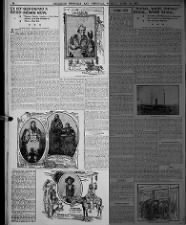 1901 newspaper account of Geronimo's life at Fort Sill Sun, Apr 14, 1901 – Page 14 · Democrat and Chronicle (Rochester, New York) · Newspapers.com
1901 newspaper account of Geronimo's life at Fort Sill Sun, Apr 14, 1901 – Page 14 · Democrat and Chronicle (Rochester, New York) · Newspapers.com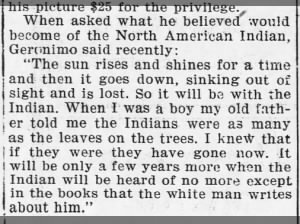 Quote attributed to Geronimo about what he thinks will happen to Native Americans Fri, Apr 4, 1902 – Page 6 · The Charlotte News (Charlotte, North Carolina) · Newspapers.com
Quote attributed to Geronimo about what he thinks will happen to Native Americans Fri, Apr 4, 1902 – Page 6 · The Charlotte News (Charlotte, North Carolina) · Newspapers.com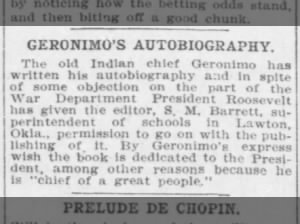 Geronimo writes his autobiography, called "Geronimo: His Own Story" Tue, Oct 23, 1906 – Page 6 · The Washington Times (Washington, District of Columbia) · Newspapers.com
Geronimo writes his autobiography, called "Geronimo: His Own Story" Tue, Oct 23, 1906 – Page 6 · The Washington Times (Washington, District of Columbia) · Newspapers.com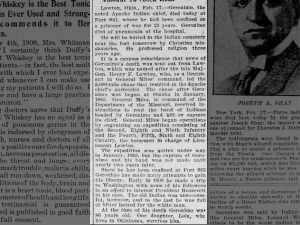 News of Geronimo's death at Fort Sill in 1909 Thu, Feb 18, 1909 – 5 · The Baltimore Sun (Baltimore, Maryland) · Newspapers.com
News of Geronimo's death at Fort Sill in 1909 Thu, Feb 18, 1909 – 5 · The Baltimore Sun (Baltimore, Maryland) · Newspapers.com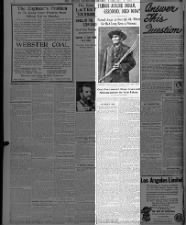 Photo and account of Geronimo's life, published after his death in 1909 Wed, Feb 17, 1909 – 8 · The Boston Globe (Boston, Massachusetts) · Newspapers.com
Photo and account of Geronimo's life, published after his death in 1909 Wed, Feb 17, 1909 – 8 · The Boston Globe (Boston, Massachusetts) · Newspapers.com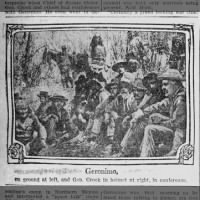 Picture of Geronimo and General Crook, featured in a 1909 newspaper 27 Feb 1909, Sat The Los Angeles Times (Los Angeles, California) Newspapers.com
Picture of Geronimo and General Crook, featured in a 1909 newspaper 27 Feb 1909, Sat The Los Angeles Times (Los Angeles, California) Newspapers.com "A popular 1889 sketch by Frederic Remington of Geronimo and his fellow Apache warriors" 15 Feb 2009, Sun The Daily Oklahoman (Oklahoma City, Oklahoma) Newspapers.com
"A popular 1889 sketch by Frederic Remington of Geronimo and his fellow Apache warriors" 15 Feb 2009, Sun The Daily Oklahoman (Oklahoma City, Oklahoma) Newspapers.com